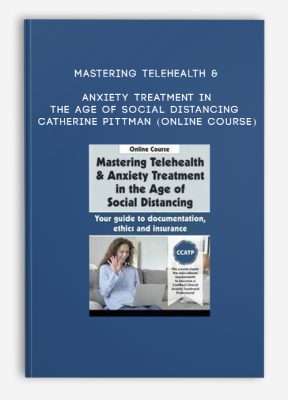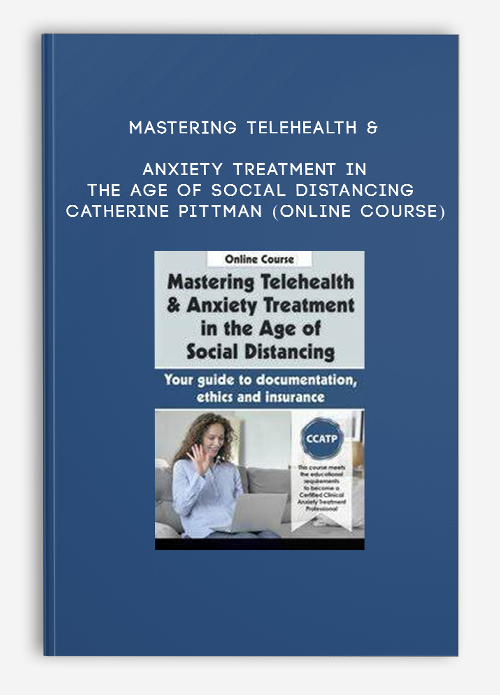Mastering Telehealth & Anxiety Treatment in the Age of Social Distancing – CATHERINE PITTMAN (Online Course)
$1,319.00 $262.00

Mastering Telehealth & Anxiety Treatment in the Age of Social Distancing – CATHERINE PITTMAN (Online Course)
Sale Page
Archive Page
Get Mastering Telehealth & Anxiety Treatment in the Age of Social Distancing – CATHERINE PITTMAN (Online Course) on Salaedu.com
Description:
Your clients need you in these times more than ever.
Anxiety is flooding their lives as they worry about loved ones, health, finances, stability and futures.
But your ability to safely and responsibly work with clients in-person has been drastically altered. In many cases, therapy has completely halted for those who desperately need it.
And it could stay that way for days, weeks and possibly months.
If you’ve never worked with telehealth or considered providing distance therapy services, now is the time.
You may have questions…
What are the legal and ethical risks? Is distance therapy even effective? How do I get started?
Certified Clinical Telemental Health Provider, Joni Gilbertson, has answers.
Filled with best practices, case studies, and treatment adaptations for working virtually, her new intensive online certification training provides the education you need to confidently and competently offer safe, effective telehealth services to your clients — allowing you to work from a variety of settings, including your home or office.
PLUS… Joni has been joined by leading anxiety treatment specialist Catherine M. Pittman, Ph.D., HSPP, for a comprehensive look at how you can use neuroscience to inform why, how and what techniques will stop the symptoms of anxiety — even the tough to treat panic attacks, worry, rumination, nausea, and pounding hearts.
Completely online and self-paced, you can view this comprehensive certification training whenever and wherever the time is right.
Once you complete this training you’ll immediately qualify to become a Certified Clinical Telemental Health Provider PLUS a Certified Clinical Anxiety Treatment Professional (CCATP).
Step 1: Watch the online course
Step 2: Complete the CE test and instantly print your certificate of completion.
Step 3: Submit your certificate of completion, professional license, and certification applications to Evergreen Certifications.
- Work with clients without leaving your home
- Gain access to clients practicing social distancing or remote clients
- Grow your practice in troubling economic times
- Become a Certified Clinical Telemental Health Provider
- Become a Certified Clinical Anxiety Treatment Professional
- Work with anxiety more effectively than ever before in a world full of uncertainty
- Practice within your boundaries of competence when using technology
- Gain competency in the legal and ethical requirements associated with privacy, security and crossing state lines
- Learn how to adapt use for various populations and disorders
- Protect yourself from common privacy violations when texting or emailing clients
Your complete guide to distance therapy! Filled with best practices, case studies, and treatment adaptations for working virtually, this intensive training will provide you the education you need to confidently and competently offer safe, effective telehealth services to your clients — allowing you to work from a variety of settings, including your home or office.
What You Need to Know Before You Get Started
- The Types of Telehealth
- Synchronous Format – Live Interaction via Video
- Asynchronous Format – Transfers of Information Electronically
- Evidence Supporting the Effectiveness of Telehealth for Clients and Various Populations
- The Benefits and Risk for Telehealth
- Recent Trends in Telehealth
- Following a Code of Ethics
- Legal Implications of Practicing Across State Lines
- Privacy & Security
- HIPAA Compliance Concerns
- Documentation & Paperwork Issues
- Ensure Data Protection & Avoid Unintended Access/Disclosure
- The Client’s Perception of Privacy via Videoconferencing
- Boundary Issues More Likely to Arise in Telehealth
- Multicultural Issues in Telehealth
- Technology Competence of the Clinician and Client
- Offering Your Telehealth Services – Where to Begin?
- How to Introduce the Concept to Clients
- Who is a Good Fit for Telehealth? Who is Not?
- Administrative Responsibilities
- Policies & Procedures Consideration – Protect Yourself and Your License
- Informed Consent – Unique Concerns & Best Practices
- Intake Process – Tips You Need to Know
- Emergency Plan for Telehealth
- Client Interviewing & Assessment Techniques
- Videoconferencing vs. Telephone
- Best Practices for Professionalism
- Camera Placement, Background, Proximity & Dress Attire
- Handling Technical Issues
- Marketing Concerns with Telehealth Practice
- Billing & Reimbursement Strategies – Is This Covered Under My Client’s Insurance Policy?
- Payment Fee Structure Considerations
- Communication of Payment Structure to Client
- Professional Liability Insurance – Telehealth Covered?
- Client Expectations & How They Differ Versus In-Person Therapy
- Financial, Accounting & Tax Concerns
- Giving and Getting Referrals – Issues for Telepractice
What Technology is Right for You and Your Clients?
- An Overview of the Various Platforms Available
- Demonstrations of Key Features
- How to Assess What Features are Important for You
- Cost Comparisons
- What Legal Assurances Do I Need from A Platform Provider?
- Client Considerations When Choosing a Platform
- What Technology is My Client Using & Where From?
- A Guided Tour of How to Begin a Telehealth Videoconferencing Session
- What Videoconferencing Looks Like in Practice
- Key Techniques to Enhance the Telehealth In-Session Experience
- Presentation Skills & Tips
- Text Message & Email Telehealth – Security, Privacy & Expectations
- Cloud Storage – What are the legal issues?
- Virtual Reality – What You Need to Know
- Disorders
- Discuss Key Adjustments Recommended for Practicing Telehealth for Different Disorders
- Populations
- Evidence & Best Practices for Tailoring Telehealth to a Variety of Clients
- Important Adaptations for Groups or Couples
- Modalities
- Which Modalities Most Easily Apply to Telehealth & Which Could Use Adaptions
- Possible Future New Rules & Regulations
- Up & Coming Technology Trends to Be Aware Of
- What Distance Therapy Might Look Like in 10 years
In Part 2, you’ll see how neuroscience can inform why, how and what techniques can help your clients stop the symptoms of anxiety — even the tough to treat panic attacks, worry, rumination, nausea, and pounding hearts.
More than just the neurobiological “whats and whys,” you’ll also learn the “hows” of actual treatment — so you’ll know exactly how to empower your clients with strategies to resist anxiety-igniting cognitions and find deep, lasting relief from panic, worry, trauma and obsessions.
- How you can help your anxious clients understand their own symptoms, feelings, interpretations, beliefs
- What to do when treatment strategies for anxiety produce anxiety
- How to work within the goal of changing the brain rather than the goal of reducing anxiety
- How neuroplasticity makes the brain more resistant to anxiety
- Simple explanations you can share with clients about how anxiety travels through their brain
- Why amygdala management is essential for all Anxiety Disorders, PTSD, OCD, Depression
- The amygdala’s role in the stress/fear/anxiety response and formation of emotional memories
- How to train the brain to stop responding to negative anxiety “triggers”
- The Vagus nerve’s role in recovery from the activation of the sympathetic nervous system
- Interventions that reduce anxiety “fuel” produced in the amygdala
- Using exposure: safely activating the fear circuitry created in the amygdala to generate new connections
- How the cortex constructs reality
- How to resist the effects of anticipation and the healthy (adaptive) use of worry
- “Survival of the busiest” principle — strengthen or weaken specific circuitry
- How to recognize and modify the impact of uncertainty
- Left hemisphere techniques: How to use cognitive defusion, coping thoughts, and fighting anticipation
- Right hemisphere techniques: How to use imagery and music
- The myth of the chemical imbalance
- Tools for assessing medication use during the initial intake
- How SSRIs and SNRIs promote neuroplasticity
- The danger of sedating the brain with benzodiazepines
- An overview of buspirone, beta blockers and sedatives/hypnotics/z-drugs
- The effectiveness of CBT and meds
- Tools for helping clients learn to reduce avoidance and push through anxiety
- How to prepare clients for exposure: psychoeducation, breathing training, cognitive restructuring
- In vivo vs. imaginal exposure approaches
- Interoceptive triggers and methods for exposure
- Use of Subjective Units of Distress/Discomfort Scale (SUDS)
- Concerns associated with safety signals, medications, distraction
- How to troubleshoot problems
- Defining basic emotional reactions: Attachment, Aversion, Indifference
- How to practice self-acceptance and erase the detrimental effect of judgment
- Using mindfulness to explore thoughts, sensations, and emotional reactions
- How to use the power of intention to focus thoughts in new directions
- Tools for coping with common reactions to aversion
- Using CBT and neurological knowledge to strengthen client engagement
- Advantages of the strategic use of neuroscience in CBT
- Why focusing on logic and disputing has limits
- Using skills-based approaches in CBT to provide the brain experiences to learn
- How the hippocampus impacts negative thinking
- Exercises to help clients focus on the positive
- Addressing worry, rumination, and common cognitive errors in depression
- Benefits of goal setting and behavioral activation
- Key role of social support and social interaction
- How to challenge distorted thoughts and unrealistic beliefs and images
- How to identify and stop anxiety-igniting thoughts common in OCD and GAD
- Strategies for helping clients embrace uncertainty
- Making OCD or worry the adversary: Don’t be bullied!
- Why clients should schedule obsessions or worries to bring them under control
- Explaining implicit emotional learning and identifying examples
- How to assist the client to experience the memory structure in the present moment
- How to promote your client’s experiential learning of emotional truth
- Steps for disconfirming the emotional memory with “mismatching” information that invalidates it
NLP online course
So what is NLP?
Firstly, NLP stands for Neuro-Linguistic Programming. Secondly neuro refers to your neurology;
Thirdly linguistic refers to language however, programming refers to how that neural language functions.
As a result,In other words, learning NLP is like learning the language of your own mind!
Moreover, NLP is the study of excellent communication–both with yourself, and with others.
It was developed by modeling excellent communicators and therapists who got results with their clients.
NLP is a set of tools and techniques, but it is so much more than that.
In conclusion, It is an attitude and a methodology of knowing how to achieve your goals and get results.
More Course: NLP – HYPNOSIS – PHILOSOPHY
Outstanding Course:The Essential Acceptance & Commitment Therapy Online Course – DANIEL J MORAN (Online Course)
1 review for Mastering Telehealth & Anxiety Treatment in the Age of Social Distancing – CATHERINE PITTMAN (Online Course)
Add a review Cancel reply
Related products
HYPNOSIS - NLP Courses
HYPNOSIS - NLP Courses
HYPNOSIS - NLP Courses
Christina Hall – The Paradoxical Nature of Change – Video Book










king –
We encourage you to check Content Proof carefully before paying.
“Excepted” these contents: “Online coaching, Software, Facebook group, Skype and Email support from Author.”
If you have enough money and feel good. We encourage you to buy this product from the original Author to get full other “Excepted” contents from them.
Thank you!